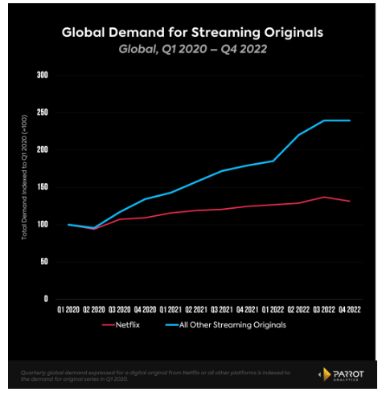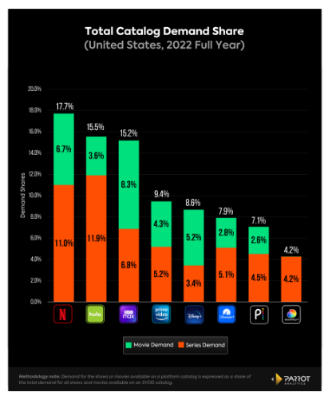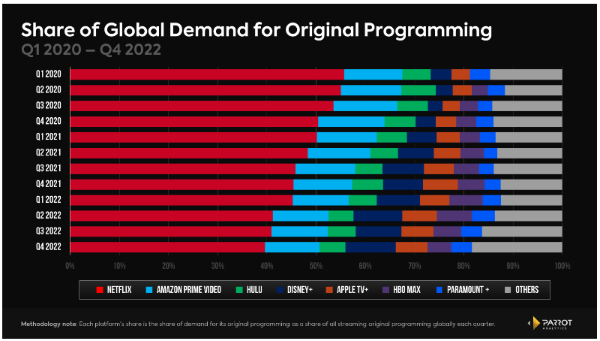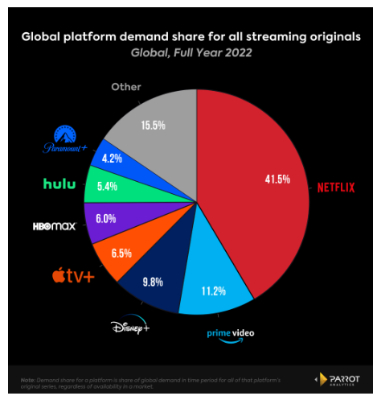Netflix will set the tone for the entire entertainment industry’s 2023 when it reports earnings later today.
Parrot Analytics data for both Q4 and full year 2022 paints a picture of an incumbent ceding ground to century-old entertainment institutions, with a clear Big Three emerging in the streaming game between Netflix, Disney, and Warner Bros. Discovery, especially if the latter two are able to consolidate platforms.
The most surprising data point for the quarter showed that the total global demand for all original SVOD series shrank by 1.6% in Q4 2022 compared to Q3.
This ended a run of nine consecutive quarters of growth, and may serve as a troubling signal for the entire industry considering demand for SVOD originals is a key leading indicator of subscriber growth.
This decrease in demand is also a possible warning sign that the global streaming market may be nearing a saturation point, suggesting that consumers have quite literally seen enough, or at the very least are done adding new SVODs to their inflation-impacted personal budgets.
This comes at the same time that entertainment giants are pulling back on content spending growth, and reassessing which metrics matter to Wall Street and certain activist investors. One major item for everyone watching today, on top of the topline subscriber numbers: will Netflix break out its new AVOD tier’s financial performance?
Netflix is still the streaming industry leader, but it has reached a point where it is now copying tactics and strategy from its legacy competition, and not the other way around.
Total Global Demand for Streaming Originals: Netflix vs All Others

- When looking at the total demand for SVOD originals, the data from Q4 2022 offered a strong signal that the global SVOD industry may be approaching saturation levels.
- After nine consecutive quarters of growth, the total demand for original content on Netflix reversed course and shrank in Q4 2022, down 4.1% compared to Q3 2022.
- After record breaking demand for Stranger Things in Q3 this isn’t a major surprise. The total demand in Q4 2022 was still 1.85% higher than Q2 2022, thanks to a new season of Emily in Paris and breakout smash hit Wednesday, among others.
- What is surprising is the trend of demand growth for originals on all other streamers combined. After growing 139.8% between Q1 2020 and Q3 2022, that growth effectively flatlined in Q4 2022, with total demand for all streamers besides Netflix up a minuscule 0.05%.
- Taken together, the total global demand for original TV series on all SVODs shrank by 1.6% in Q4 2022.
Total Catalog Demand Share — TV & Movies Combined: US, FY 2022

- This is Parrot Analytics’ first ever reveal of the total demand for each major SVOD’s full catalog — all TV and movies, both licensed and originals, combined.
- During the year 2022, Netflix had the most in-demand overall catalog at 17.7% share with US audiences.
- This broader look at the streaming landscape shows a more competitive field than demand for original TV content only, with a clear Big Three — Hulu (15.5%) and HBO Max (15.2%) are both within striking distance of Netflix.
- However, when factoring in potential future platform consolidation at both Disney and Warner Bros. Discovery, Netflix would fall into third place. Hulu and Disney+ combined would be 24.1%, while HBO Max and Discovery+ combined would be 19.4%, both outpacing Netflix’s 17.7%.
- While demand for original content drives subscription growth, library content is key for customer retention, and the catalog demand is a good indicator of which SVODs consumers are most likely to use as a default ‘streaming home.’
- Breaking it down further, HBO Max is the leader in catalog demand for movies but in third place for TV. Hulu is the leader in TV but is in fifth place with movies. Netflix’s second-place position in each of those categories puts it over the top when all the demand is combined.
Global Streaming Original TV Demand Share Q1 2020-Q4 2022

- In Q4 2022, Netflix’s global share of demand for original TV content fell below 40% for the first time ever, dropping to 39.6%. In the United States, Netflix’s share dipped to 40.9% from 41.5%, but that was still ahead of the US record low of 40.5% in Q2 2022.
- The stronger numbers in Q3 2022 were fueled by record breaking demand for season four of Stranger Things, which hit higher peak demand than any streaming original we have tracked (data goes back to 2015).
- Disney+’s demand share grew almost a full percentage point in Q4 2022, up to 10.2%. This is the highest ever quarterly global demand share for Disney+, and the first time the platform has cracked double digits. Disney+ is now within one point of overtaking Amazon Prime Video (11.1%) for second place in global demand for streaming original series.
- The Disney+ growth was driven by demand for its flagship franchises: Marvel and Star Wars. Disney+ originals accounted for four of the top 10 most in-demand streaming originals with global audiences in Q4 2022: #4 Andor (51.5x more in-demand than the average show globally) #5 She Hulk: Attorney at Law (50.6x), #7 The Mandalorian (43.8x), and #10 Moon Knight (39.6x).
Global Streaming Original Demand Share Full Year 2022

- For the full year 2022, Netflix’s global demand share for original TV content fell to 41.5%. Netflix finished at 47.1% in 2021, and 53.5% in 2020.
- Fellow legacy streaming outlets Hulu (5.8% to 5.4%) and Prime Video (12.2% to 11.2%) also lost demand share in 2022.
- So which
outlets cut into Netflix’s lead? The SVODs that gained the
most demand share in original TV content in 2022
were:
- Disney+ (7.4% to 9.8%)
- HBO Max (5.0% to 6.0%)
- Paramount+ (3.2% to 4.2%)
- Apple TV+ (5.8% to 6.5%)
- These platforms combined for a 5.1 percentage point gain in 2022, accounting for the vast majority of Netflix’s 5.6% year over year loss.



 NZ Certified Builders: BCITO And NZCB Announce Apprentice Challenge 2025
NZ Certified Builders: BCITO And NZCB Announce Apprentice Challenge 2025 NIWA: Seasonal Climate Outlook February To April 2025
NIWA: Seasonal Climate Outlook February To April 2025 Bill Bennett: Are New Zealand's Submarine Links Safe?
Bill Bennett: Are New Zealand's Submarine Links Safe? Bill Bennett: DeepSeek Shock Could Spur AI Space Race
Bill Bennett: DeepSeek Shock Could Spur AI Space Race Auckland Property Investors Association: APIA Cautions - New Rental Rules Not A Landlord's Free Pass
Auckland Property Investors Association: APIA Cautions - New Rental Rules Not A Landlord's Free Pass Federated Farmers: Farmers Welcome Kāinga Ora Back-track On Wool Carpets
Federated Farmers: Farmers Welcome Kāinga Ora Back-track On Wool Carpets



